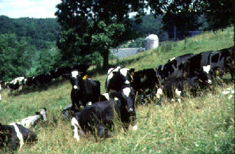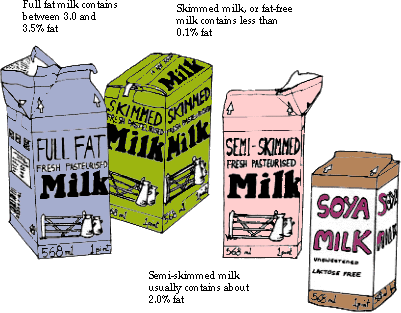Milk
Milk is an emulsion of oil in water,
meaning that there are oil droplets in a water solute  (continuous water phase).
Milk consists of 87% water. The
oil is made up of 3.5% dissolved protein, 3.6% lipids (fats), 4.9% carbohydrates
and 0.7% vitamins and minerals. Complex
phospholipids and protein molecules surround the droplets of fat, this
stabilises them so that the oil does not separate easily from the water.
Although, if left to stand, cream will form on the surface of the milk
and so the droplets are not completely stabilised. Lactose is the main carbohydrate in milk, this is a
disaccharide, meaning it consists of two monosaccharide molecules.
A monosaccharide is a carbohydrate that cannot be split by dilute acids.
Lactose is sometimes referred to as ‘milk sugar’, it comprises of one
glucose molecule linked to a galactose molecule. It is manufactured in the mammary gland of the cow and only
occurs in milk.
(continuous water phase).
Milk consists of 87% water. The
oil is made up of 3.5% dissolved protein, 3.6% lipids (fats), 4.9% carbohydrates
and 0.7% vitamins and minerals. Complex
phospholipids and protein molecules surround the droplets of fat, this
stabilises them so that the oil does not separate easily from the water.
Although, if left to stand, cream will form on the surface of the milk
and so the droplets are not completely stabilised. Lactose is the main carbohydrate in milk, this is a
disaccharide, meaning it consists of two monosaccharide molecules.
A monosaccharide is a carbohydrate that cannot be split by dilute acids.
Lactose is sometimes referred to as ‘milk sugar’, it comprises of one
glucose molecule linked to a galactose molecule. It is manufactured in the mammary gland of the cow and only
occurs in milk.
 Milk is a good source of calcium, which is
important for growth and development. Calcium
is a component of teeth and bones and is present in the blood as it is required
for muscle contraction and other metabolic processes.
Milk is a good source of calcium, which is
important for growth and development. Calcium
is a component of teeth and bones and is present in the blood as it is required
for muscle contraction and other metabolic processes.
If milk is left to stand,
fat molecules rise to the top and form a layer of cream. The thickness of
the cream varies depending on weather, pasture that cow is grazing and lactation
cycles. The layer of cream becomes rancid before the milk underneath and
so the thicker the layer of milk the faster the milk will go bad. To
reduce the cream layer the milk undergoes homogenisation.
Homogenisation is a
process in which the fat is distributed throughout the milk by forcing it
through tiny nozzles at high pressure. The large fat molecules of the
cream are broken down from sizes of about two or three micrometres to roughly a
tenth of that diameter. These smaller molecules are less buoyant and as
they have a high surface area relative to their volume, there is a greater
resistance to motion through the milk compared to the original fat
molecules. The fat molecules also get coated with more proteins become
more resistant to being squeezed together. This means that the smaller
molecule are less likely to rise to the surface or clump together and so a layer
of cream is not produced.
A fine
dispersion of calcium caseinate suspended in the milk causes the colour to be
white.
 (continuous water phase).
Milk consists of 87% water. The
oil is made up of 3.5% dissolved protein, 3.6% lipids (fats), 4.9% carbohydrates
and 0.7% vitamins and minerals. Complex
phospholipids and protein molecules surround the droplets of fat, this
stabilises them so that the oil does not separate easily from the water.
Although, if left to stand, cream will form on the surface of the milk
and so the droplets are not completely stabilised. Lactose is the main carbohydrate in milk, this is a
disaccharide, meaning it consists of two monosaccharide molecules.
A monosaccharide is a carbohydrate that cannot be split by dilute acids.
Lactose is sometimes referred to as ‘milk sugar’, it comprises of one
glucose molecule linked to a galactose molecule. It is manufactured in the mammary gland of the cow and only
occurs in milk.
(continuous water phase).
Milk consists of 87% water. The
oil is made up of 3.5% dissolved protein, 3.6% lipids (fats), 4.9% carbohydrates
and 0.7% vitamins and minerals. Complex
phospholipids and protein molecules surround the droplets of fat, this
stabilises them so that the oil does not separate easily from the water.
Although, if left to stand, cream will form on the surface of the milk
and so the droplets are not completely stabilised. Lactose is the main carbohydrate in milk, this is a
disaccharide, meaning it consists of two monosaccharide molecules.
A monosaccharide is a carbohydrate that cannot be split by dilute acids.
Lactose is sometimes referred to as ‘milk sugar’, it comprises of one
glucose molecule linked to a galactose molecule. It is manufactured in the mammary gland of the cow and only
occurs in milk. Milk is a good source of calcium, which is
important for growth and development.
Milk is a good source of calcium, which is
important for growth and development.